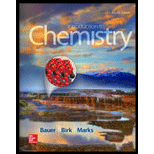
Concept explainers
Interpretation:
The molality of acetic acid solution is to be determined.
Concept Introduction:
Molarity
Molality
Answer to Problem 112QP
Solution:
Molality of given acetic acid solution is 1.058 m.
Explanation of Solution
Given Information: The molarity of Acetic acid solution is
Substitute
The number of moles
The molar mass of acetic acid is as follows:
Substitute
The density
The density of acetic acid solution is
The mass of solvent is equal to the mass of solution minus the mass of solute.
Substitute
Substitute
The molality of the acetic acid solution is 1.058 m.
Want to see more full solutions like this?
Chapter 11 Solutions
Introduction to Chemistry
- Water at 25 C has a density of 0.997 g/cm3. Calculate the molality and molarity of pure water at this temperature.arrow_forwardSolutions Introduced directly into the bloodstream have to be isotonic with blood; that is, they must have the same osmotic pressure as blood. An aqueous NaCl solution has to be 0.90% by mass to be isotonic with blood. What is the molarity of the sodium ions in solution? Take the density of the solution to be 1.00 g/mL.arrow_forwardVodka is advertised to be 80 proof. That means that the ethanol (C2H5OH) concentration is 40% (two significant figures) by volume. Assuming the density of the solution to be 1.0 g/mL, what is the freezing point of vodka? The density of ethanol is 0.789 g/mL.arrow_forward
 General Chemistry - Standalone book (MindTap Cour...ChemistryISBN:9781305580343Author:Steven D. Gammon, Ebbing, Darrell Ebbing, Steven D., Darrell; Gammon, Darrell Ebbing; Steven D. Gammon, Darrell D.; Gammon, Ebbing; Steven D. Gammon; DarrellPublisher:Cengage LearningChemistry: Matter and ChangeChemistryISBN:9780078746376Author:Dinah Zike, Laurel Dingrando, Nicholas Hainen, Cheryl WistromPublisher:Glencoe/McGraw-Hill School Pub Co
General Chemistry - Standalone book (MindTap Cour...ChemistryISBN:9781305580343Author:Steven D. Gammon, Ebbing, Darrell Ebbing, Steven D., Darrell; Gammon, Darrell Ebbing; Steven D. Gammon, Darrell D.; Gammon, Ebbing; Steven D. Gammon; DarrellPublisher:Cengage LearningChemistry: Matter and ChangeChemistryISBN:9780078746376Author:Dinah Zike, Laurel Dingrando, Nicholas Hainen, Cheryl WistromPublisher:Glencoe/McGraw-Hill School Pub Co Chemistry by OpenStax (2015-05-04)ChemistryISBN:9781938168390Author:Klaus Theopold, Richard H Langley, Paul Flowers, William R. Robinson, Mark BlaserPublisher:OpenStax
Chemistry by OpenStax (2015-05-04)ChemistryISBN:9781938168390Author:Klaus Theopold, Richard H Langley, Paul Flowers, William R. Robinson, Mark BlaserPublisher:OpenStax Chemistry & Chemical ReactivityChemistryISBN:9781337399074Author:John C. Kotz, Paul M. Treichel, John Townsend, David TreichelPublisher:Cengage Learning
Chemistry & Chemical ReactivityChemistryISBN:9781337399074Author:John C. Kotz, Paul M. Treichel, John Townsend, David TreichelPublisher:Cengage Learning Chemistry & Chemical ReactivityChemistryISBN:9781133949640Author:John C. Kotz, Paul M. Treichel, John Townsend, David TreichelPublisher:Cengage Learning
Chemistry & Chemical ReactivityChemistryISBN:9781133949640Author:John C. Kotz, Paul M. Treichel, John Townsend, David TreichelPublisher:Cengage Learning Principles of Modern ChemistryChemistryISBN:9781305079113Author:David W. Oxtoby, H. Pat Gillis, Laurie J. ButlerPublisher:Cengage Learning
Principles of Modern ChemistryChemistryISBN:9781305079113Author:David W. Oxtoby, H. Pat Gillis, Laurie J. ButlerPublisher:Cengage Learning





